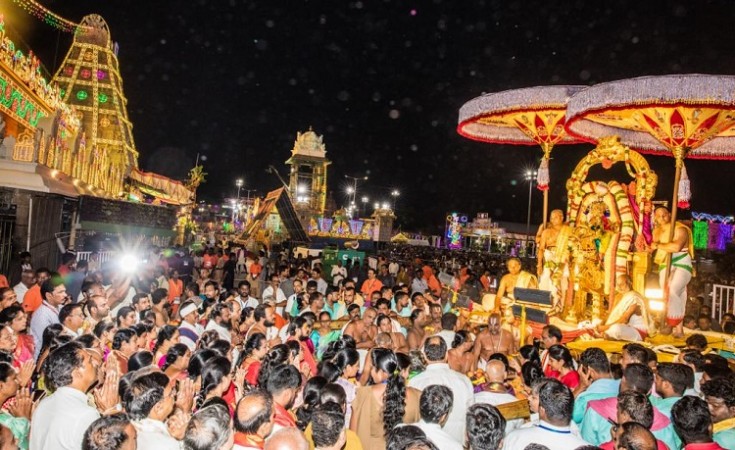
Tirumala: Commencing the auspicious Salakatla Brahmotsavam today is a grand celebration of devotion to Shri Venkateswara Swamy. On the eighth day of these sacred festivities in Tirumala, the embodiment of divinity in Kaliyuga, Sri Malayappa Swamy, graced devotees while adorned in resplendent Kalki attire, riding gracefully on an exquisite horse-drawn carriage. This divine procession unfolded from 7 pm to 9 pm, with majestic elephants leading the way, and devotees harmonizing bhajans, kolatas, and jiyyangars, serenading the Lord with Vedic mantras. The atmosphere resonated with the melodious sounds of mangal instruments, creating an enchanting ambiance for devotees at every step.
Today marks the Ankurarpana ceremony, a seed offering performed in preparation for the Dwajarohana, signifying the Lord's enjoyment of festivals (utsavams). In Tirumala, every moment is a celebration of divinity.
Under the vigilant guidance of Srivari Senadhipati Vishvaksen, budding programs will unfold today. As night falls, the southwest of the temple will witness the worship of Bhudevi, followed by the collection of Mrithika, earth symbolizing purity, which is then ceremoniously transported to the temple in a grand procession known as the 'Mritsangrahana Yatra' or Puttamannu Collection. This act symbolizes the cultivation of new grains, a process called Ankurarpana.
The Swarna Rathotsavam is scheduled for October 2, gracing the festival with its splendor from 4 pm to 5 pm. In Tirumala, where every moment is a festivity, the Brahmotsavam takes center stage, filled with significant rituals:
Aalaya Suddhi: The temple of Lord Sri Venkateswara undergoes a meticulous cleansing, followed by adornment with flowers and mango leaves, a process known as Alankaram.
Mritsangrahanam: The collection of earth, performed a day before the start of Brahmotsavam, is accompanied by prayers to deities and Mother Earth. This collected earth is then used for the Ankurarpanam ritual, where nine varieties of grains are sown.
Dwajarohanam and Devatavanam: The hoisting of the Garudadhwaja flag at Dwajasthambham, near Nadimi Padi Kavili, initiates the Brahmotsavam. The flag symbolizes the invitation of celestial beings and sages by Garuda.
Vahana Seva: The Lord embarks on processions through Tirumala's streets on various Vahanas (vehicles), each conveying a unique message.
Srivari Koluvu: During Brahmotsavam, the Lord holds court within the main temple after the procession, where priests perform Naivedyam.
Snapanam: Following the procession, the Lord undergoes a ceremonial herbal water bath, relieving the strain endured during the festivities.
Choornabhishekam: Anointing the Lord and his consorts with sandalwood powder precedes a procession around Tirumala's streets. Devotees receive the blessed sandalwood powder, believed to remove obstacles.
Chakrasnanam: This ritual resembles the bathing ceremony after a Yagna. On the final day of Brahmotsavam, the Lord and his consorts, along with the Sudarshanachakram, are bathed in the Swami Pushkarini, open to devotees of all backgrounds.
Devatodwasanam: The last day sees the ceremonial send-off of rishis and Gods to Devalokam after the daily Archana. Lord Brahma receives accolades for organizing the Utsavam, honored by temple priests and officials.
Dwajavarohanam: Concluding the festivities, the flag hoisted on the first day of Brahmotsavam is lowered on the last evening.
In Tirumala, the Salakatla Brahmotsavam is not merely an event; it is an embodiment of devotion, tradition, and divine celebration, resonating in every facet of this sacred abode.